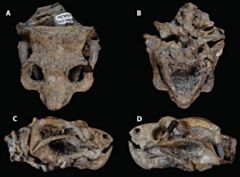Project 4895: Z. Macungo, R. Araújo, C. Browning, RMH Smith, R. David, KD Angielczyk, A. Massingue, S. Ferreira-Cardoso, DJP Kortje. 2023. Novel anatomy and paleobiological insights on Cistecephalus microrhinus (Synapsida: Dicynodontia). Festschrift Louis Jacobs. NA (NA):NA. (In Press)
Abstract
While Cistecephalus microrhinus is a well-researched dicynodont taxon, our study using bone-by-bone manual segmentation of micro-computed tomography scans has unveiled a plethora of new insights into its paleobiology, anatomy, and variation. We detail the neuroanatomy of two South African Cistecephalus specimens, SAM-PK-K6814 and SAM-PK-011474, and shed light on the internal three-dimensional structures of the Cistecephalus skull. Our findings also clarify previously ambiguous contacts in serial-sections and highlight external morphological features previously obscured by the species' small size, taphonomic deformation, overpreparation, or matrix obstructions. We specifically studied the evolution of the postfrontal in emydopoids and propose that its development may have stemmed from co-ossification with the postorbital, rather than element deletion.Our examination of the inner ear's anatomy allowed the calculation of the thermo-motility index. This supports the notion that cistecephalids, and other dicynodonts, were likely ectotherms—a stance that challenges a recent hypothesis based on the angle between semicircular canals. Both Cistecephalus and its closely related taxon, Kawingasaurus, were found to have typical angles between these canals. This emphasizes the significance of considering the utricular section of the canal when measuring angles and, hence, making paleobiological inferences. Additional evidence supporting the ectothermic nature of cistecephalids, despite their atypical brain morphology, comes from propagation phase-contrast synchrotron tomography scans. These scans did not reveal mammalian-like complex turbinals; instead, these structures appear to be the result of sediment infilling. Given this, and when contextualized within the Permian Karoo paleoclimate, it is plausible that Cistecephalus underwent brumation in winter, aligning with its fossorial traits.Read the article »
Project DOI: 10.7934/P4895, http://dx.doi.org/10.7934/P4895
| This project contains |
|---|
Download Project SDD File |
Currently Viewing:
MorphoBank Project 4895
MorphoBank Project 4895
- Creation Date:
28 September 2023 - Publication Date:
14 October 2023 - Media downloads: 6

Authors' Institutions ![]()
- Instituto de Plasmas e Fusão Nuclear
Members
| member name | taxa |
specimens |
media |
| Ricardo Araújo Project Administrator | 2 | 3 | 69 |
Project has no matrices defined.
Project downloads 
| type | number of downloads | Individual items downloaded (where applicable) |
| Total downloads from project | 34 | |
| Media downloads | 6 | M894598 (1 download); M894628 (1 download); M894601 (1 download); M894542 (1 download); M894580 (1 download); M894498 (1 download); |
| Project downloads | 9 | |
| Document downloads | 19 | Phylogenetic matrix (discrete characters only, to open in Mesquite) (4 downloads); Phylogenetic matrix (continuous and discrete; to open in TNT) (9 downloads); Phylogenetic analysis (List of apomorphies) (2 downloads); Phylogenetic analysis (Bremer support) (1 download); Phylogenetic analysis (branch support: symmetric resampling, GC values) (2 downloads); Matrix 1a (1 download); |

